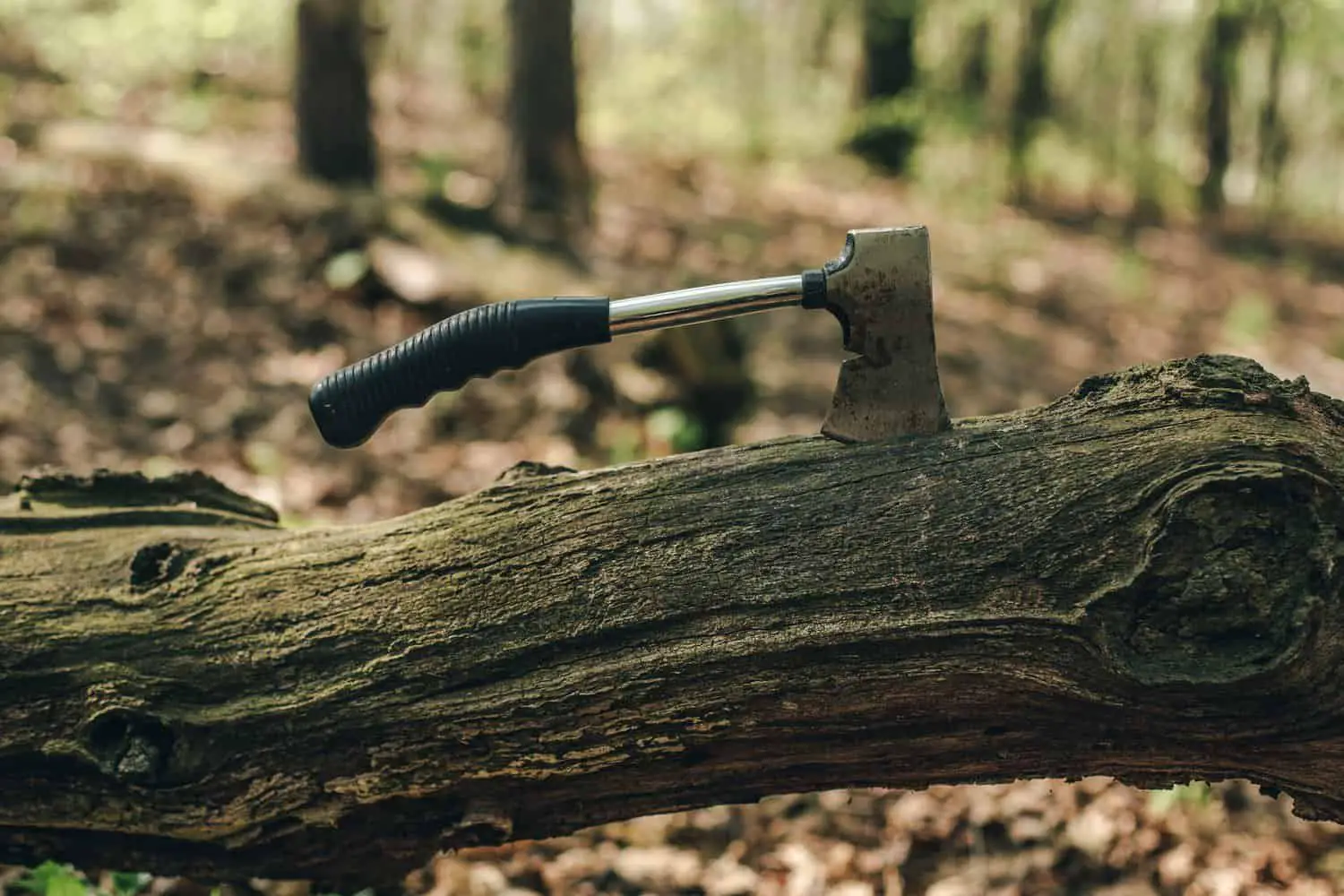When you’re on the trail, a good hatchet can mean the difference between warmth and discomfort. While you’ll probably use the tool primarily for procuring firewood, the butt end can pull double duty as a hammer.
It might also come in handy if you find yourself in a self-defense situation. Here’s a guide to help you find the best backpacking hatchet.
Quick Look
- Fiskars 378501-1002 X7 14″ Hatchet
- Gerber Pack Hatchet Camping Axe
- Estwing Sportsman’s Axe
- Estwing Camper’s Axe
- Gerber Bear Grylls Survival Hatchet
- SOG Camp Axe
- IUNIO Camping Axe Multi-Tool Hatchet
- CRKT Woods Chogan Tomahawk Axe
- Promithi Camping Hatchet Axe
- Gerber 9-Inch Hatchet
- Hults Bruk Tarnaby Hatchet
In A Hurry?
Our Top Pick – Gerber 9-Inch Hatchet
Shopping For A Backpacking Hatchet: What You Need To Know
Things To Look For In A Hatchet
Size and Weight
The handle of a camping hatchet can measure anywhere from 9 to 20 inches. Since you’re looking for a tool that can fit easily into your backpack, it’s a good idea to err on the shorter side. As far as the weight is concerned, try to find a hatchet that you’ll feel comfortable carrying for 6-12 hours a day.
Material
Some purists will say wood is the best material for a handle… I could be convinced. However, a low-quality wood is prone to splintering, especially during hard strikes. Wood can also be slippery to grasp, which increases the risk of damage. With other materials offered such as lightweight plastic, fiberglass or full steel construction, you should look at what material, length, and style will fit your needs the best.
Durability
In addition to a fiberglass handle, a good backpacking hatchet should feature sturdy steel construction. Sometimes, you’ll find a hatchet that’s forged in a single solid piece, with a leather grip on the handle. These are usually long-lasting and reliable units, but they’re also fairly heavy.
Balance
A well-balanced hatchet will reduce the stress on your arms and lower back. To test the balance, try placing the hatchet on the corner of a table, with the head extending over the edge. If the head takes a sharp nosedive off the table, the center of gravity is likely too close to the shoulder.
Sharpness
The best backpacking hatchets will hold their edge over time, requiring very little maintenance. If you invest in a hatchet, you may still want to bring along a mill file in case the blade needs sharpening on the trail.
Multi-use
Some hatchets can also be used as hammers or pry bars. They’re typically called “3-in-1” or “multi-use” hatchets, and they’ll come in especially handy on extended treks. Bear in mind, however, that they might not be as well-balanced as hatchets that are designed specifically for chopping.
Price
Invest in the best-quality hatchet you can afford. Often, when it comes to camping equipment, a lower price means a significant dip in quality. You should be able to tell by the overall look and feel of the model, but pricier hatchets will typically last longer and give you a better return on your investment.

What Are The Different Parts Of A Hatchet?
Tang
Also called the shank, this is the portion of the blade that connects to the handle.
Head
The “business end” of the hatchet, with the broad blade on one end and the thicker butt end on the other.
Blade
The portion of the head that does the actual splitting. A properly sharpened blade should be fine enough to cut into your fingernail when you lightly press against it.
Accessories
Sharpening Stone
As mentioned above, you should use a mill file for sharpening a backpacking hatchet on the trail. For home use, try to find a stone with both a coarse grit (120) and a fine grit (300 or more). This will allow you to hone and refine the blade more effectively.
Sheath
A durable sheath will protect the head of your hatchet when it’s not in use. It could also keep the blade from accidentally slicing into your belongings.
Beeswax
This substance is invaluable for oiling the blade after use.
Learn The Different Hatchet Styles
Survival
This is a no-frills hatchet that’s designed to withstand years of use. If you’re looking for a multi-use tool, a survival hatchet is probably not your best bet.
Camping
These hatchets may typically feature longer handles and heavier heads than the ones designed specifically for backpacking.
Backpackers
A backpacking hatchet should be light, portable, and effective. Many of these models are designed as multi-use units, with hammer and pry bar functions.
Hatchet Care
How to sharpen a hatchet
It’s no more difficult to sharpen a hatchet than a carving knife, but there are a few caveats. First of all, you’ll want to start out using a coarse grain to eradicate any larger nicks or imperfections in the blade.
Position the head of the hatchet so that the blade meets the file at approximately the same angle as the bevel. Pull the file across the blade in five or six long, even strokes, then repeat on the other side.
When you’ve finished with the coarse grain, switch to the finer grit to hone the blade. Repeat the same technique described above with about a dozen long strokes on each side, or until the blade is sufficiently sharp.
For a visual aid on how to sharpen a hatchet, check out this YouTube tutorial.
Preventative Care
To keep your hatchet from rusting, be sure to dry it thoroughly after use. Never put a hatchet blade away wet. For best results, lightly oil the blade before replacing the sheath. It doesn’t need to be fancy—just keep a cloth and a small stash of beeswax or linseed oil in your backpack.
Common Questions
What is a full tang hatchet?
A full tang hatchet features a blade that extends down the entire length of the weapon’s handle. Conversely, the blade on a partial tang hatchet will reach only partway down the handle, and is usually attached by other means.
Which is better: A hatchet or a saw?
For shorter trips, a hatchet is a more energy-efficient choice. It’s better at harvesting small amounts of firewood, as well as kindling. However, if you’re planning an extended stay in the wilderness and need to build your own shelter, a camping saw will be more effective at cutting through large logs.
If you’re looking for a hunting tool that can chew through bones, a saw is also a better choice.
How is a hatchet different from an axe?
The main difference is the size: A hatchet is designed for light chopping, whereas an axe can handle tougher jobs. Also, the head of a hatchet is typically smaller and narrower, with a broader blade and a more pronounced taper.
Finally, note that the shaft of a hatchet will usually curve forward so that the head is in line with the bottom-most portion of the handle.
Best Backpacking Hatchet: Product Review Guide
1. Fiskars 378501-1002 X7 14″ Hatchet
This hatchet has a straight handle with a slight curve at the end for gripping. At just 14 inches, it’s the ideal size for backpacking. Fiskars offers a lifetime warranty with the purchase of this model.
2. Gerber Pack Hatchet Camping Axe
The Gerber Pack Hatchet Camping Axe is a full tang hatchet with an easy-to-grip rubber handle and a nylon sheath that can be attached to your belt. At just under 9.5 inches, it’s also one of the shortest and most portable models on our list.
3. Estwing Sportsman’s Axe
This is another full-tang blade, forged as a single piece with hand-sanded and lacquered leather applied to the handle. At 12 inches, it’s small enough to fit into most backpacks, but be forewarned that it’s heavier than some of the competition.
4. Estwing Camper’s Axe
This second offering from Estwing is another full-tang hatchet, this one measuring 16 inches long. This makes it a better choice for double-handed swinging, but fitting it into your pack might be more of a challenge.
5. Gerber Bear Grylls Survival Hatchet
This offering from Gerber measures 13 inches long and weighs in at just 1.4 pounds, so it’s ideal for backpacking. The tough rubberized handle is easy to grip, and the 3.5-inch blade is as effective on slender limbs as on tough logs.
6. SOG Camp Axe
The handle on this axe is perfectly straight, with a textured handle for gripping. It also comes equipped with a glass-reinforced nylon sheath with one of the most effective designs we’ve seen.
The axe measures 11.5 inches long and weighs in at just over a pound, so it’s easy to carry. SOG offers a lifetime warranty, as long as your tool has been properly maintained.
7. IUNIO Camping Axe Multi-Tool Hatchet
This is a full-scale survival kit. In addition to the hatchet itself…which measures 16.93 inches and weighs just over 2 pounds…you’ll get a working compass, a flint, a whistle, a hammer, a fish scale tool, and a bottle opener. Also included is a sheath for the handle, featuring a camouflage design.
8. CRKT Woods Chogan Tomahawk Axe
This tomahawk-style axe has an old-fashioned design that will appeal to your inner Cub Scout. The 19-inch handle is constructed of solid Tennessee hickory, and the butt end is blunt and heavy enough to drive in the most stubborn tent stakes. Speaking of heavy, the axe weighs in at just under two pounds, which is impressive considering how sturdy it is.
9. Promithi Camping Hatchet Axe
The uniquely carved head on this 13-inch hatchet looks like it can do some serious damage, with a broad blade for chopping and a thinner, curved blade in the back. A beautifully sanded wood handle adds to its aesthetic appeal. The drawback? There’s no butt end to help drive in nails or tent stakes.
10. Gerber 9-Inch Hatchet
Gerber comes out swinging with this 9-inch hatchet, which weighs just 1.21 pounds and can be easily tucked into your pack for multi-day treks. The blade holds its edge through multiple uses, and it’s ideal for slicing through smaller limbs for kindling.
11. Hults Bruk Tarnaby Hatchet
The sleekly designed head of this hand-forged hatchet comes attached to a curved hickory handle measuring 15 inches in length. The head itself weighs 1.25 pounds, but the overall weight is a bit too hefty for long treks.
Note that the handle is treated with linseed oil, so if you choose this model, you should use that instead of beeswax for the most consistent results.
The Verdict
If we could take just one of these backpacking hatchets along on a hiking trip, it would have to be the Gerber 9-Inch Hatchet. It’s small and light enough to fit easily in our pack, and the blade holds its edge well after repeated uses.
Since the composite handle is shock-absorbent, it’s also easy to wield after a long day in the woods. You might pay a bit more than you would for similarly-sized models, but in our opinion, this hatchet is worth it.
We wish you the best of luck on the next step in your backpacking adventures!












